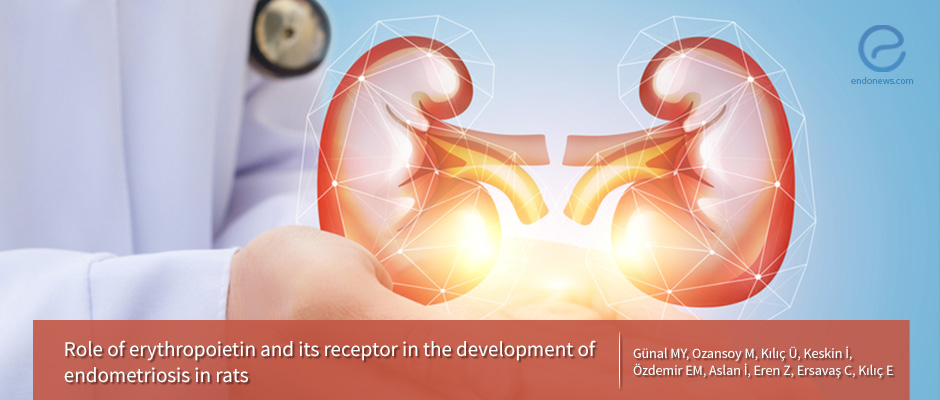Kidney Hormone Potential Treatment for Endometriosis?
Oct 3, 2018
The hormone in question, called erythropoietin, is responsible for promoting red blood cell production in the bone marrow.
Key Points
Highlights:
- Erythropoietin treatment can reduce the size and number of endometrial lesions in a rat model of endometriosis.
Importance:
- Erythropoietin could, therefore, be a promising candidate for the treatment of endometriosis.
What's done here:
- Researchers induced endometriosis in a rat model and then treated the animals for three weeks. with erythropoietin, a synthetic form of erythropoietin called darbepoetin, and a compound called Mircera, which activates erythropoietin receptors.
- They assessed the size of the endometriotic lesions after three weeks of treatment, and at the end of every three-week periods after the cessation of the treatment for nine weeks to see if endometriosis recurred. They also analyzed the animals histopathologically.
Key results:
- Erythropoietin, darbepoietin, and Mircera treatment all reduced lesion size in rats with endometriosis after three weeks of treatment.
- The lesion size in all treatment groups was lower three weeks after the end of the treatment period, however, it was significantly decreased only in erythropoietin-treated animals.
- Endometriosis lesions were significantly lower in all treatment groups at the end of the third three weeks.
- The decrease in lesion sizes in animals treated with erythropoietin and Mircera was more pronounced than that of animals treated with darbepoetin three weeks after the end of treatment.
- Erythropoietin and darbepoietin were more effective than Mircera based on histopathology.
- Endometriosis did not recur in any of the groups three weeks following the end of treatment.
Limitations:
- The experiments were conducted in an animal model and the results may not be the same for humans.
- More research is needed to further explore the potential role of erythropoietin as a treatment for endometriosis.
- The potential side effects of such a treatment were not investigated in this study and must be taken into consideration for erythropoietin to be considered as a potential therapeutic candidate for the disease.
Lay Summary
Erythropoietin, a hormone produced by the kidneys to promote the production of red blood cells could be a promising candidate for the treatment of endometriosis. This is according to a study published in the Journal Of The Turkish-German Gynecological Association by Dr. Mehmet Yalçin Günal and colleagues.
Apart from the kidneys, erythropoietin and the receptor that it binds to, are also found in the cells lining the uterus. These are the cells that start growing outside the uterus in endometriosis.
Previous research in a mouse model has shown that erythropoietin plays a role in estrogen-dependent blood vessel formation in the uterus. Moreover, erythropoietin levels are increased in the fluid produced in the abdominal cavity of patients with endometriosis. Finally, erythropoietin has been shown to protect the heart muscle, lungs, and nervous system, and is a promising therapeutic candidate for degenerative diseases.
In order to understand the role of erythropoietin and its receptor in the development of endometriosis, the team of researchers led by Dr. Ertuğrul Kılıç at İstanbul Medipol University School of Medicine in Turkey used a rat model of the disease.
The researchers first induced endometriosis in the animals by surgically attaching endometrial tissues on the inner wall of their abdomen and then treating them with estrogen to promote the growth of the endometrial tissue.
After three weeks, they treated the animals with erythropoietin, darbepoetin, a synthetic form of erythropoietin, or Mircera, a compound that activates the erythropoietin receptor and that is used to treat anemia, low red blood cells in the body. The treatment lasted for three weeks. Then, the researchers analyzed endometrial lesions after cessation of the treatment for every three-week periods for 9weeks to check whether endometriosis returned.
They found that the size of the endometrial lesions was reduced in all treatment groups compared to controls. However, only the size of the lesions of the animals treated with erythropoietin was significantly decreased after three weeks of treatment.
When the researchers checked the size of the lesions again after another three weeks from the end of the treatment, they saw that the lesion sizes in all treatment groups were significantly lower than the control. The decrease in lesion sizes in animals treated with erythropoietin and Mircera was more pronounced compared to animals treated with darbepoetin.
When they examined the animals histo-pathologically, the researchers saw that erythropoietin and darbepoetin were more effective than Mircera.
The authors speculated that erythropoietin’s lesion-reducing effect could be due to its antioxidant properties or the antioxidant effects of biological pathways in which it might play a role.
They concluded that erythropoietin may be a promising candidate for the treatment of endometriosis. Because it is already being routinely used in patients with kidney insufficiency erythropoietin is known to be an efficient and safe treatment. However, large-scale clinical trials in women with endometriosis are needed before it can be used in the treating this group of patients.
Research Source: https://www.ncbi.nlm.nih.gov/pubmed/29916217
erythropoietin rat model Mircera darbepoietin erythropoietin receptor anemia

